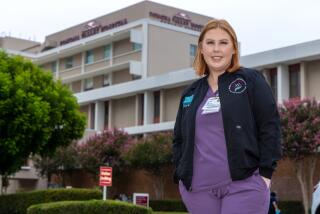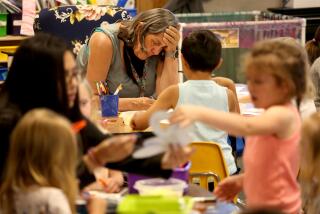NURSE: A Special Role in Schools : School Nurse of the Year Is a Story of High Dedication, Education, Low Pay
- Share via
SAN DIEGO — “One of the most common places you’ll find choking victims is in restaurants,” said Gloria Stipe. “Now, what’s usually the first thing people do at a restaurant?”
Her question was greeted with a few blank stares.
“They’ll have a drink,” she said. “That has an effect on the throat, making it more susceptible to choking.”
Students were gathered in groups of seven or eight in the University City High School choral room, which had been transformed temporarily into a first-aid classroom. Some of the students were lying on the floor patiently waiting while their heads were adjusted by friends in preparation for mouth-to-mouth resuscitation. In the corner of the room was another group listening to a lecture on the causes and treatments of choking.
The lecturer was Stipe, 56, winner of San Diego and Imperial counties’ “School Nurse of the Year” award. Stipe, like the more than 100 other school nurses in the San Diego Unified School District, would like to see today, which is School Nurse Day in California, as the time to begin a new understanding of the role of school nurses.
When the class ended at 9:30 a.m., it was a brief walk back to Stipe’s office through the high school campus and past a courtyard where a banner hung, conveying, “Congratulations Nurse Stipe” from the Associated Student Body.
There was little in her small office except a Band-Aid decorating her coffee cup and her plaque on the wall to label her as a nurse. In fact, there was little about Stipe that seemed to fit the old image of the school nurse.
The school nurse always seemed to be the person who couldn’t give you aspirin. Sometimes she would give you a Band-Aid or a cup of tea. She was usually middle-aged, called you “Dear” and seemed to spend an inordinate amount of time knitting or showing pictures of her grandchildren. No matter what your malady, she would feel your head and then have you lie down on a cot until your mother could come to school and take you to someone who could actually do something about your problem.
Very little of the school nurse’s inability to act was her fault. State laws had tied her hands. The laws have changed, but the image remains.
“You know, we still can’t give aspirin,” Stipe said, laughing. “I mean, isn’t that ridiculous, especially when you consider the kind of training we have to go through to be a school nurse. But at least most everything else about the school nurse has changed.”
Nurses can give medication only with parental consent and doctor’s orders.
Stipe appears to be the prototype of the new school nurse. She was one of 37 nurses nominated by administrators from elementary and secondary schools in San Diego and Imperial counties for the first school nurse award given by the 155-member chapter of the California School Nurses Organization.
Served With Navy
She was selected on the basis of her ability to inspire students of all backgrounds and to achieve maximum health results, the school nurses organization said.
Stipe has been a school nurse in San Diego County for about 14 years. Before that, she was assistant chief nurse at the Naval Hospital in San Diego, during part of the 21 years she served in the Navy Nurse Corps.
She is active in six state and national education nursing organizations as well as in several student, parent and teacher groups at University City High School. She has taught courses on asthma, diabetes, cardiopulmonary resuscitation, and drug and alcohol abuse. Stipe also organized several local Bloodmobile drives.
She seems to have little time for knitting.
“I had retired from the Navy in 1971, but not because I was tired of working,” she said. “I just no longer wanted to be an administrator. I was looking for a change, and found I missed working with patients. So I decided to become a school nurse.”
Stipe spent two years working in elementary schools, eight years in junior highs, and the last four years in high schools.
“I think of all of them I liked junior highs the best,” she said. “That’s where the action is. They’re into so many things, you just never know what’s going to happen next.
“They’re still uncoordinated in junior high, so they fall down a lot. And there’s also a lot of athletic injuries from the P.E. classes. The kids will also try and fake you out more in junior high. But after enough experience, you can always spot the fakers. There’s just something about a person who is really sick.
“In high school, you find more emotional problems. You don’t have near the number of P.E. accidents. In all, I think stomachaches and headaches are the most common problems. I believe a lot of that is from stress. Many students have jobs, so they’re not getting the proper rest. And they’re not eating properly.”
In addition to attending to emergencies, Stipe is responsible for state-mandated health programs such as vision, dental, hearing and scoliosis checks. There also are tuberculosis tests and immunization programs. School nurses who are nurse practitioners, which means they have had an additional year of training, also handle the physicals for sports.
“The job has really grown,” she said. “Unfortunately the general public doesn’t know this. It’s been such a problem undoing our image. It’s a very individual career now. School nurses can function better in their role and be as innovative and creative as they desire. Much more is expected of us. It’s exciting work.”
It isn’t, however, the best-paying work. Stipe, who has about 36 years of experience in nursing and will retire this year, is earning $27,000 a year. That’s considered a relatively high salary for a school nurse.
“That’s a large part of the problem,” said Edie Gold, chairman of the California School Nurses Organization and a nurse for three elementary schools in the San Diego Unified School District. “Most nurses these days don’t consider a school nurse career as very worthwhile. It’s just not very attractive, and in fact it’s considered a step down. There’s very little in the way of financial rewards and very little job security. Budget cuts can end your career.”
Gold, who has spent 10 years as a school nurse and has 25 years’ nursing experience, earns $20,000 a year. She said a new school nurse can expect to make about $15,000. Those are short wages when compared to the amount of training required.
Besides an R.N. certificate, they must have a bachelor’s degree in nursing and a school nurse credential. Sixty percent to 70% of school nurses in the San Diego district are nurse practitioners.
That amounts to five to seven years of training. Master’s degrees aren’t required, but Gold said the nurses are encouraged to get them. Plus, they must accrue 30 hours of continuing education classes every two years to remain an R.N.
“There’s no question,” Gold said, “when you consider the training involved, you don’t become a school nurse for the money or the security. I could probably make almost twice at a hospital to what I’m making here. The school nurses are a special breed and maybe something of a sucker for punishment.
“You do it because you enjoy working with the children. It’s different and challenging. You’re looking at every aspect of nursing from skin disorders to the handicapped. You also have to deal with child abuse and drug abuse. It’s changed from the old ‘Band-Aid Brigade’ stereotype.
“What you have to remember is that society has changed. A lot of these kids come from single-parent homes or homes where both parents work. So the parents just can’t always keep their kids at home when they’re sick the way they used to.”
Gold stopped her conversation to take care of a girl called Katie who was in her second week with the Philippine flu, which has been making the rounds this month in San Diego and Los Angeles schools.
“What worries me is the time when more school nurses will be needed and none will be available,” she said after popping a thermometer in Katie’s mouth. “More nurses are needed. But, of course, funding is a problem. You see, that’s one of the myths. The public thinks each school has a full-time nurse. Actually, in the elementary schools, it’s not uncommon for one nurse to be responsible for three different schools. The average ratio is 1 nurse per 1,200 students, but it can be as high as 1 per 1,400 students.”
Gold checked the thermometer and found that Katie still had a fever. She told Katie to return to her class and thatshe would contact her mother about medication, and about whether the mother wanted to take Katie home.
“You do make a difference here,” Gold said, watching Katie leave. “Whether it’s taking care of a sick child or seeing that another one gets new glasses, there’s a lot of satisfaction.”
More to Read
Sign up for Essential California
The most important California stories and recommendations in your inbox every morning.
You may occasionally receive promotional content from the Los Angeles Times.













